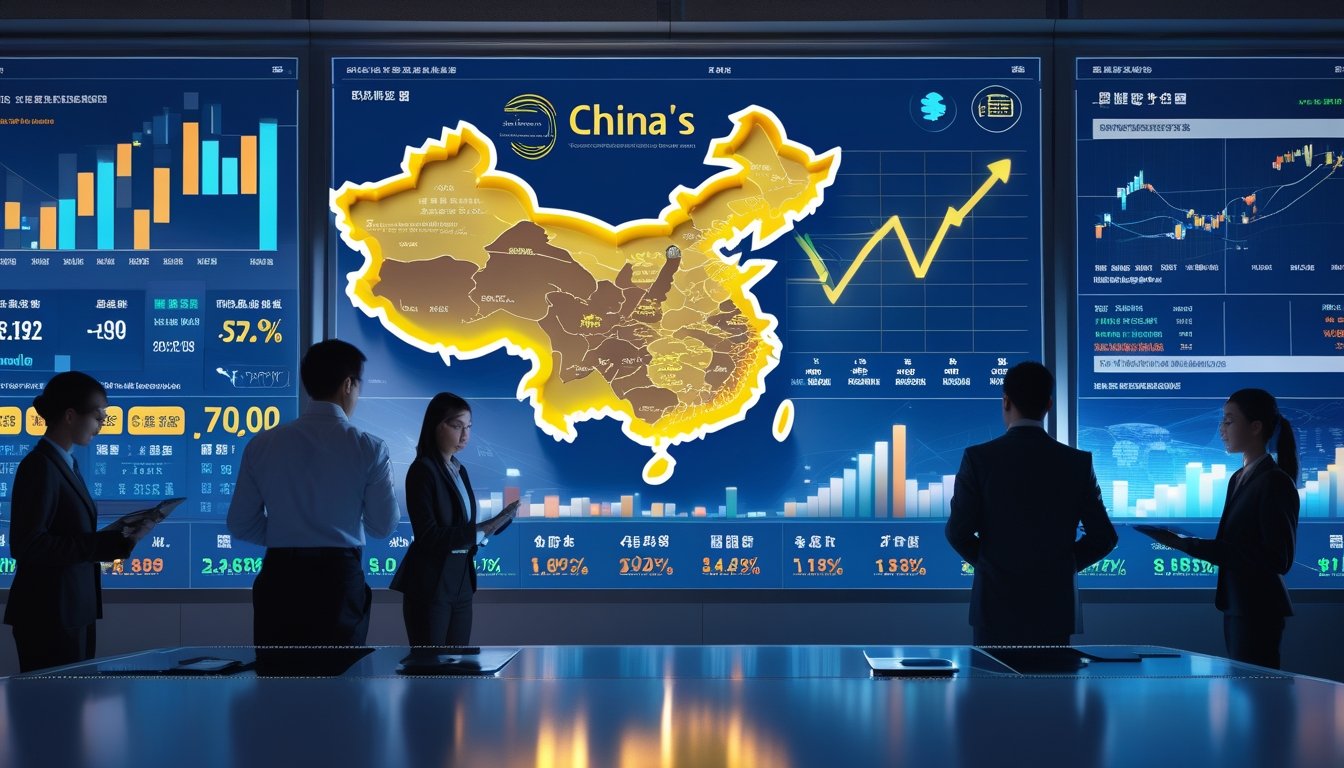China’s gross domestic product (GDP) is one of the most closely watched indicators in global markets. As the world’s second-largest economy, shifts in China’s GDP growth can influence everything from trade flows to investment strategies.
For investors, understanding the drivers behind China’s GDP is more than just tracking numbers—it’s about anticipating opportunities and risks. Changes in policy, industry performance, or global demand can reshape markets overnight.
By examining why China’s GDP matters, investors can make informed decisions and protect their portfolios with the right strategies and legal guidance.
Curious about where growth is headed? Explore business opportunities in China to see where investors can benefit most.
What China’s Gross Domestic Product Reveals

China’s GDP highlights fast growth, dependence on certain industries, and the strong influence of state policy. It lays out both the opportunities and risks you face when weighing China as an investment market.
Measuring Growth and Economic Health
China’s GDP gives you a sense of both size and direction. Nominal GDP ranks China as the world’s second-largest economy after the U.S., but if you use purchasing power parity (PPP), China actually comes out ahead. That matters—PPP is about what people can really buy within China.
Growth has slowed compared to the breakneck pace of previous decades. Back in the 1990s and 2000s, China averaged around 9% growth, but by 2024, it was closer to 5%. Projections for 2025 sit between 4% and 5%. Why slower? Real estate, exports, and consumer demand have all hit some bumps.
It’s worth mentioning: official GDP figures aren’t always the full story. Independent trackers—like the Federal Reserve Bank of San Francisco’s China Cyclical Activity Tracker—use things like electricity use and freight volumes to get a clearer picture. Not flawless, but these tools help investors double-check the numbers.
Sectors Driving China’s GDP
Industry and manufacturing make up nearly 37% of China’s GDP—more than double the U.S. share. The service sector is about 57% and growing, but still lags behind most advanced economies.
Key industries include:
- Manufacturing and exports: Electronics, machinery, consumer goods
- Construction and real estate: Big driver, but also a financial risk
- Services: Finance, tech, retail—growing, but uneven across regions
Regional gaps are huge. Coastal cities like Shanghai and Beijing have per capita GDPs similar to advanced economies, while many inland provinces are still closer to developing-world levels. This unevenness shapes both consumer markets and where investment makes sense.
Government Policies and Their Influence
China’s GDP performance is deeply connected to government policy. The state sets growth targets, directs credit, and picks industrial priorities. Big stimulus moves—like infrastructure spending—can boost short-term growth but also add to long-term debt.
China’s economy has nudged a bit toward domestic consumption, but policies still lean heavily on industry and global trade. In 2024, about 30% of GDP growth came from exports—the highest since the late 1990s.
Policy swings can quickly change the landscape for investors. Moves to regulate tech firms, control property, or grow state-owned enterprises can shift growth drivers overnight. Watching how Beijing balances stability and reform is key—that balance often decides which sectors take off and which get squeezed.
Global Implications of China’s GDP

China’s economic ups and downs shape trade flows, commodity demand, and financial markets around the world. Changes in its growth rate force other countries to rethink exports, resource use, and investment strategies.
Impact on International Trade and Supply Chains
As China’s GDP grows, its appetite for imported goods and raw materials rises. That’s good news for exporters in Asia, Europe, and North America selling machinery, electronics, and food to China.
China’s spot in global supply chains is massive. Industries like electronics, autos, and textiles depend on Chinese factories for components. A slowdown there can throw off manufacturing schedules and push up costs for companies everywhere.
Trade data from early 2025 shows exports to emerging markets like ASEAN and Africa are growing steadily. That reduces China’s reliance on the U.S. and EU, but it also means supply chain shocks hit a wider range of economies. If you’re investing, tracking these flows is crucial—they feed straight into company earnings in lots of regions.
Effects on Commodity and Energy Markets
China buys more steel, copper, and coal than anyone else. When its GDP growth shifts, commodity prices move fast. For example, a 6% jump in industrial output in 2025 drove up demand for metals used in construction and manufacturing.
Energy markets react in much the same way. Strong growth means more oil and gas imports; weaker growth eases global demand. That hits exporters like Saudi Arabia, Russia, and Australia, who rely heavily on Chinese buyers.
China’s push into renewables and electric vehicles is changing the game, too. Lithium, nickel, and rare earths are getting more valuable. Meanwhile, traditional fossil fuel imports may level off or even drop. Keeping an eye on these trends helps you spot price moves in both old and new energy sectors.
Investor Sentiment and Market Volatility
Markets jump or drop with China’s GDP announcements. Better-than-expected growth can boost global stocks, while weak numbers sometimes spark sell-offs across Asia and beyond.
Sectors react differently. Tech and industrials often do well when Chinese demand is strong. Luxury brands and consumer goods depend more on household spending.
China’s property market and private investment add another layer of uncertainty. In 2025, real estate investment fell over 11%, raising worries about financial stability. These risks show up in investor sentiment, affecting currency values, bond yields, and stocks worldwide.
If you’re managing a portfolio, staying on top of these shifts helps you adjust your exposure and tweak your strategy as economic signals change.
Thinking about entering the market? Learn more in our guide: Is it safe to do business in China?.
Legal and Strategic Considerations for Investors
You’ve got to consider China’s changing regulatory landscape, how you structure investments for stability, and when to lean on legal expertise. Getting these right lowers your risk and helps you find sustainable opportunities.
Navigating Regulatory Shifts in China
China’s government shapes industries through policy shifts, licensing, and foreign ownership rules. These changes hit sectors like tech, manufacturing, and finance in different ways. Policies can move fast, especially in areas tied to national priorities like energy, data, or advanced manufacturing.
To keep up, monitor official announcements and follow updates from regulators. Watch for rules on capital flows, profit repatriation, and joint venture requirements.
Here’s a quick checklist:
- Check compliance needs before entering a sector.
- Watch policy signals from plans like the Five-Year Plan.
- Adjust your exposure if you see more scrutiny in a sector.
Being proactive helps you avoid sudden shocks to your investment plans.
Structuring Investments for Stability
How you set up your investment in China affects its resilience to market or policy surprises. Direct ownership gives you more control but usually comes with tough regulatory requirements. Indirect options—like offshore holding companies or joint ventures—offer flexibility but may limit your say in decisions.
Currency risk is another factor. The renminbi isn’t fully convertible, so hedging or holding assets in multiple markets can help manage that exposure.
Here’s a quick comparison:
Structure Type
Strengths
Limitations
Direct Ownership
More control, direct profits
Higher regulatory hurdles
Joint Venture
Local access, shared risk
Less autonomy, partner dependency
Offshore Holding Co.
Flexibility, tax advantages
Complex setup, less transparency
The best choice depends on your risk appetite, sector, and long-term aims.
When to Seek Professional Legal Guidance
Legal advice is crucial for tough contract talks, protecting intellectual property, or dealing with sector-specific rules. Tech and healthcare investments, for example, often involve complex licensing and strict data laws.
Work with local legal experts who know both Chinese and international law. That way, you’ll avoid costly mistakes and make sure your contracts stick.
Get legal help especially when you’re:
- Drafting joint venture or partnership deals
- Protecting trademarks or patents
- Handling cross-border taxes
- Responding to regulatory probes
Bringing in legal pros early on makes it easier to work within China’s legal system and protect your investment.
Need tailored advice for your investment strategy? Discover our full range of legal services in China.
Conclusion: China Gross Domestic Product
China’s gross domestic product is more than an economic figure—it reflects the country’s influence on global markets and the opportunities and challenges facing investors. Understanding these shifts helps businesses and individuals position themselves strategically.
As policies evolve and sectors rise or slow, the need for clear legal and financial guidance becomes even more important. Proactive planning ensures investors can adapt and protect their interests.
To explore how China’s legal framework shapes investment opportunities, we invite you to read our article on the China Foreign Investment Law.
Frequently Asked Questions
People often compare China’s economy with the U.S. because both dominate global output. But it’s important to separate economic size from actual wealth or development—those aren’t always the same thing.
Who is the no. 1 GDP country?
The United States leads in nominal GDP, reaching about $28 trillion in 2024. China ranks second by dollars. But in PPP terms, China takes the top spot.
Is China richer than the USA?
China’s GDP is huge, but per person, the U.S. is far wealthier. In 2024, U.S. GDP per capita topped $80,000, while China’s was under $13,000. The average American earns much more than the average Chinese citizen.
Is China #1 in GDP?
No, China isn’t number one in nominal GDP—the U.S. still leads. But China ranks first in PPP-adjusted GDP. That means it produces more goods and services when adjusting for cost of living.
Is China a developed country?
China is still classified as a developing country by most organizations. Its income levels and social systems lag behind advanced economies. Yet with strong industries and global influence, it sits somewhere between developing and developed.
Subscribe to receive updates
Subscribe to receive the latest blog posts to your inbox every week.



